New Evidence about the Polychromy of Early Imperial Cycle from the Augusteum of Rusellae (Tuscany)
Abstract
1. Introduction
1.1. Rusellae and the Augusteum
1.2. Polychromy
1.3. Aim of the Project
2. Materials and Methods
3. Results
4. Discussion
4.1. The Cuirassed Statue: The Breastplate
4.2. The Cuirassed Statue: The Hemline
4.3. Colour for Backgrounds
5. Conclusions
Supplementary Materials
Author Contributions
Funding
Data Availability Statement
Acknowledgments
Conflicts of Interest
References
- Liverani, P. Il Foro di Rusellae in epoca romana. Atlante Temat. di Topogr. Antica 2011, 21, 15–31. [Google Scholar]
- Catalli, F. Ritrovamenti di Monete negli Scavi di Roselle. Le Campagne 1959–1967. Annali dell’Istituto Italiano di Numismatica 1976–1977, 23–24, 121–150. [Google Scholar]
- De Benedetti, M.; Catalli, F. Roselle: Le Monete dagli Scavi Archeologici (1959–1991) e dal Territorio; Edizioni Effigi: Rome, Italy, 2013. [Google Scholar]
- Cappellini, B. La basilica giulio-claudia di Roselle. Atlante Temat. di Topogr. Antica 2016, 25, 215–232. [Google Scholar] [CrossRef]
- Laviosa, C. Rusellae: Relazione preliminare della settima e della ottava campagna di scavi. Studi Etruschi 1969, 37, 577–609. [Google Scholar]
- Laviosa, C. Roselle. In Enciclopedia dell’Arte Antica; Suppl. 1970; Treccani: Rome, Italy; pp. 676–677.
- Laviosa, C. Rusellae: Relazione preliminare della nona e della decima campagna di scavi (1967–1968). Parte I. Studi Etruschi 1971, 39, 521–543. [Google Scholar]
- Laviosa, C. Il vano statue. In Roselle: Gli Scavi e la Mostra; Pacini Editore: Pisa, Italy, 1975; pp. 118–119. [Google Scholar]
- Cogitore, I. Séries de Dédicaces Italiennes à la Dynastie Julio-Claudienne. Mélanges De L’ecole Française De Rome Antiq. 1992, 104, 817–870. [Google Scholar] [CrossRef]
- Bollmann, B. Römische Vereinshäuser. Untersuchungen zu den Scholae der Römischen Berufs-, Kult- und Augustalen-Kollegien in Italien; Philipp von Zabern: Mainz am Rhein, Germany, 1998. [Google Scholar]
- Boschung, D. Gens Augusta; Philipp von Zabern: Mainz am Rhein, Germany, 2002. [Google Scholar]
- Wohlmayr, W. Kaisersaal. Kultanlagen der Augustalen und Munizipale Einrichtungen für das Herrscherhaus in Italien; Phoibos Verlag: Wien, Austria, 2004. [Google Scholar]
- Romanò, E. Gli Augustales a Rusellae. Una rilettura delle testimonianze architettoniche, scultoree ed epigrafiche. Studi Class. e Orient. 2013, 59, 153–206. [Google Scholar]
- Rose, C.B. Dynastic Commemoration and Imperial Portraiture in the Julio-Claudian Period; Cambridge University Press: Cambridge, CA, USA, 1997. [Google Scholar]
- Blanck, H. [Review of]: Niemeyer, Hans Georg: Studien zur statuarischen Darstellung der römischen Kaiser. Göttingische Gelehrte Anz. 1971, 223, 86–103. [Google Scholar]
- Stemmer, K. Untersuchungen zur Typologie, Chronologie und Ikonographie der Panzerstatuen; Mann: Berlin, Germany, 1978. [Google Scholar]
- Vermeule, C.C. Hellenistic and Roman Cuirassed Statues: Concordance of Greek and Roman Cuirass Statues in Marble and Bronze; Museum of Fine Arts: Boston, MA, USA, 1980. [Google Scholar]
- Goette, H.-R. Mulleus-Embas-Calceus: Ikonographische Studien zu römischem Schuhwerk. Jahrb. des Deutsch. Archäologischen Inst. 1988, 103, 401–464. [Google Scholar]
- Romanò, E. Il loricato acefalo di Rusellae (Roselle, GR): Una proposta di identificazione. LANX 2012, 13, 141–153. [Google Scholar]
- Liverani, P.; Santamaria, U.; Verri, G. La quarta dimensione della scultura: Il colore. In Escultura Romana en Hispania VIII; Márquez, C., Ojeda, D., Eds.; Universidad de Córdoba: Cordoba, Spain, 2018; pp. 121–138. [Google Scholar]
- Michelucci, M. Roselle: La Domus dei Mosaici; Editori del Grifo: Montepulciano, Italy, 1985. [Google Scholar]
- Michelucci, M. Il gruppo di ritratti dalla Domus dei Mosaici. In Un Decennio di Ricerche a Roselle. Statue e Ritratti (Catalogo della Mostra, Antica città di Roselle, 1° Luglio—5 Agosto 1990); Edizioni Zeta: Firenze, Italy, 1990; pp. 80–93. [Google Scholar]
- Giachi, G.; Liverani, P.; Pallecchi, P. Contributi Rosellani: Stucchi e intonaci dall’Augusteo e da altri edifici minori. In Pitture Murali nell’Etruria Romana: Testimonianze Inedite e Stato dell’Arte. Atti della Giornata di Studi, Gipsoteca di Arte Antica—Università di Pisa, 22 Giugno 2015; Donati, F., Ed.; Edizioni ETS: Pisa, Italy, 2016; pp. 33–39. [Google Scholar]
- Marini Calvani, M. I colori del ciclo statuario di Veleia. Boll. d’Arte 2005, 132, 73–88. [Google Scholar]
- Skovmøller, A.; Brøns, C.; Sargent, M.L. The polychromy of the Sculpted Garments on the Statue of Gaius Fundilius Doctus in the Ny Carlsberg Glyptotek. In Polychromy in Ancient Sculpture and Architecture; Bracci, S., Giachi, G., Liverani, P., Pallecchi, P., Paolucci, F., Eds.; Sillabe: Livorno, Italy, 2018; pp. 92–99. [Google Scholar]
- Skovmøller, A. Facing the Colours of Roman Portraiture. Exploring the Materiality of Ancient Polychrome Forms; De Gruyter: Berlin, Germany, 2020. [Google Scholar] [CrossRef]
- Bonini, A.; Bracci, S.; Liverani, P.; Bartolozzi, G.; Iannaccone, R.; Lenzi, S.; Magrini, D. Oplontis, 79 AD: Colours on marble furnishing from the Villa of Poppaea. Techné 2019, 48, 90–99. [Google Scholar] [CrossRef]
- Magrini, D.; Bracci, S.; Bartolozzi, G.; Iannaccone, R.; Lenzi, S.; Liverani, P. Revealing Mithras’ Color with the ICVBC Mobile Lab in the Museum. Heritage 2019, 2, 2160–2170. [Google Scholar] [CrossRef]
- Iannaccone, R.; Bracci, S.; Cantisani, E.; Mazzei, B. An integrated multimethodological approach for characterizing the materials and pigments on a sarcophagus in St. Mark, Marcellian and Damasus catacombs. Appl. Phys. A 2015, 121, 1235–1242. [Google Scholar] [CrossRef]
- Dyer, J.; Verri, G.; Cupitt, J. Multispectral Imaging in Reflectance and Photo-Induced Luminescence Modes: A User Manual; The British Museum: London, UK, 2013. [Google Scholar]
- Available online: https://spectradb.ifac.cnr.it/ (accessed on 28 February 2023).
- Bacci, M. UV-VIS-NIR, FT-IR and FORS Spectroscopies. In Modern Analytical Methods in Art and Archaeology; Ciliberto, E., Spoto, G., Eds.; Wiley: Chichester, UK, 2000; pp. 321–360. ISBN 0-471-29361-X. [Google Scholar]
- Fuster Lopéz, L.; Stols-Witlox, M.; Picollo, M. (Eds.) UV-Vis Luminescence Imaging Techniques/Tècnicas de Imagen de Luminescencia UV-Vis (Vol. 1); Editorial Universitat Politècnica de València: Valencia, Spain, 2020. [Google Scholar]
- Verri, G.; Comelli, D.; Cather, S.; Saunders, D.; Piqué, F. Post-capture data analysis as an aid to the interpretation of ultraviolet-induced fluorescence images. In Computer Image Analysis in the Study of Art; SPIE Conference (Society of Photographic Instrumentation Engineers): San Jose, CA, USA, 2008; pp. 11–22. [Google Scholar] [CrossRef]
- Ricci, C.; Borgia, I.; Brunetti, B.G.; Miliani, C.; Sgamellotti, A.; Seccaroni, C.; Passalacqua, P. The Perugino’s palette: Integration of an extended in situ XRF study by Raman spectroscopy. J. Raman Spectrosc. 2004, 35, 616–621. [Google Scholar] [CrossRef]
- Kopczynski, N.; de Viguerie, L.; Neri, E.; Nasr, N.; Walter, P.; Bejaoui, F.; Baratte, F. Polychromy in Africa Proconsularis: Investigating Roman statues using X-ray fluorescence spectroscopy. Antiquity 2017, 91, 139–154. [Google Scholar] [CrossRef]
- Marketou, A.K.; Kouzeli, K.; Facorellis, Y. Colourful earth: Iron-containing pigments from the Hellenistic pigment production site of the ancient agora of Kos (Greece). J. Archaeol. Sci. Rep. 2019, 26, 101843. [Google Scholar] [CrossRef]
- Piening, H. Gold to Purple. Violet Traces on Antique Marble. Available online: http://www.stiftung-archaeologie.de/Heinrich%20Piening%20Gold%20to%20purple%202014.pdf (accessed on 24 February 2023).
- Siotto, E. Identification of gilding techniques on Roman marble sarcophagi. J. Cult. Herit. 2019, 38, 186–194. [Google Scholar] [CrossRef]
- Mingos, D.M.P. (Ed.) Historical Introduction to Gold Colloids, Clusters and Nanoparticles. In Gold Clusters, Colloids and Nanoparticles; Springer: Berlin, Germany, 2014. [Google Scholar] [CrossRef]
- Louis, C.; Pluchery, O. (Eds.) Gold Nanoparticles for Physics, Chemistry and Biology; Imperial College Press: London, UK, 2012. [Google Scholar] [CrossRef]
- Cadario, M. La Corazza di Alessandro. Loricati di Tipo Ellenistico dal IV sec. a.C. al II d.C.; LED Edizioni Universitarie: Milan, Italy, 2004. [Google Scholar]
- Kuttner, L. Dynasty and Empire in the Age of Augustus: The Case of the Boscoreale Cups; University of California Press: Berkeley, CA, USA, 1995. [Google Scholar]
- Settis, S. (Ed.) La Colonna Traiana; Einaudi: Torino, Italy, 1988; ISBN 10:8806598899. [Google Scholar]
- Muthmann, F. Bruchstücke einer Panzerstatue. Mitteilungen des Deutschen Archäologischen Instituts. Römische Abt. 1936, 51, 347–352. [Google Scholar]
- Poulsen, V. Les Portraits Romains. Vol. 1, République et Dynastie Julienne; Ny Carlsberg Glyptotek: Copenhagen, Denmark, 1962. [Google Scholar]
- Brinkmann, V.; Koch-Brinkmann, U. On the Reconstruction of Antique Polychromy Techniques. In Circumlitio. The Polychromy of Antique and Mediaeval Sculpture; Brinkmann, V., Primavesi, O., Hollein, M., Eds.; Hirmer Verlag: Frankfurt am Main, Germany, 2010; pp. 115–135. [Google Scholar]
- Brécoulaki, H. La Peinture Funéraire de Macédoine. Emplois et Fonctions de la Couleur Ive—IIe s. av. J.-C.; Centre de Recherches de l’Antiquité Grecque et Romaine: Athènes, Greece, 2006; ΜΕΛΕΤΗΜΑΤΑ 48. [Google Scholar]
- Bottini, A.; Setari, E. (Eds.) Il Sarcofago delle Amazzoni; Mondadori Electa: Milan, Italy, 2007. [Google Scholar]
- Benassai, R. La tomba dipinta nolana Weege 30. In Studi sull’Italia dei Sanniti; La Regina, A., Ed.; Electa: Milan, Italy, 2000; pp. 78–81. [Google Scholar]
- Menichetti, M. The Alexander Mosaic: Stories of victory. In Images at the Crossroads: Media and Meaning in Greek Art; Barringer, J.M., Lissarague, M., Eds.; Edinburgh University Press: Edinburgh, UK, 2022; pp. 91–106. [Google Scholar]
- Scrinari, S.M.V. Il Laterano Imperiale I. In Dalle «Aedes Laterani» alla «Domus Faustae»; Pontificio Istituto di Archeologia Cristiana: Vatican, Italy, 1991. [Google Scholar]
- Liverani, P. Note di topografia lateranense: Le strutture di via Amba Aradam. A proposito di una recente pubblicazione. Bull. della Comm. Archeol. Comunale di Roma 1993, 95, 143–152. [Google Scholar]
- Bracci, S.; Bartolozzi, G.; Iannaccone, R.; Magrini, D.; Liverani, P.; Lenzi, S.; Manganelli Del Fà, R. Painted marble sculptures and contextual questions in the so-called “Villa of Poppaea” at Oplontis. In Proceedings of the 10th Round Table on Polychromy in Ancient Sculpture and Architecture, Berlin, Germany, 10–13 November 2020. submitted. [Google Scholar]
- Lenzi, S. La policromia dei Monochromata. La Ricerca del Colore su Dipinti su Lastre di Marmo di Età Romana; Firenze University Press: Florence, Italy, 2016. [Google Scholar] [CrossRef]
- Freyer Schauenburg, B. Die Statue des Trajan auf Samos. Mitt. Des Dtsch. Archäologischen Inst. Athen. Abt. 2002, 117, 257–298. [Google Scholar]
- Freyer Schauenburg, B. Der Sternmantel des Kaisers Trajan. In Bunte Götter. Die Farbigkeit Antiker Skulptur; Brinkmann, V., Wünsche, R., Eds.; Staatliche Antikensammlungen und Glyptothek: München, Germany, 2003; pp. 213–215. [Google Scholar]
- Liverani, P. Per una “Storia del colore”. La scultura policroma romana, un bilancio e qualche prospettiva. In Diversamente Bianco. Policromia della Scultura Romana; Liverani, P., Santamaria, U., Eds.; Quasar: Rome, Italy, 2014; pp. 9–32. [Google Scholar]
- Liverani, P. L’invenzione della nuvola. In L’Officina dello Sguardo. Scritti in Onore di Maria Andaloro; Bordi, G., Carlettini, I., Fobelli, M.L., Menna, M.R., Pogliani, P., Eds.; Gangemi Editore: Rome, Italy, 2014; pp. 249–256. [Google Scholar]
- Anguissola, A.; Lenzi, S. La Policromia degli Elementi Non Figurati nella Scultura Greca e Romana. Proposte per uno Studio del Colore di Puntelli, Sfondi, Basi. Annu. Della Sc. Archeol. Di Atene E Delle Mission. Ital. Oriente 2019, 97, 199–215. [Google Scholar]
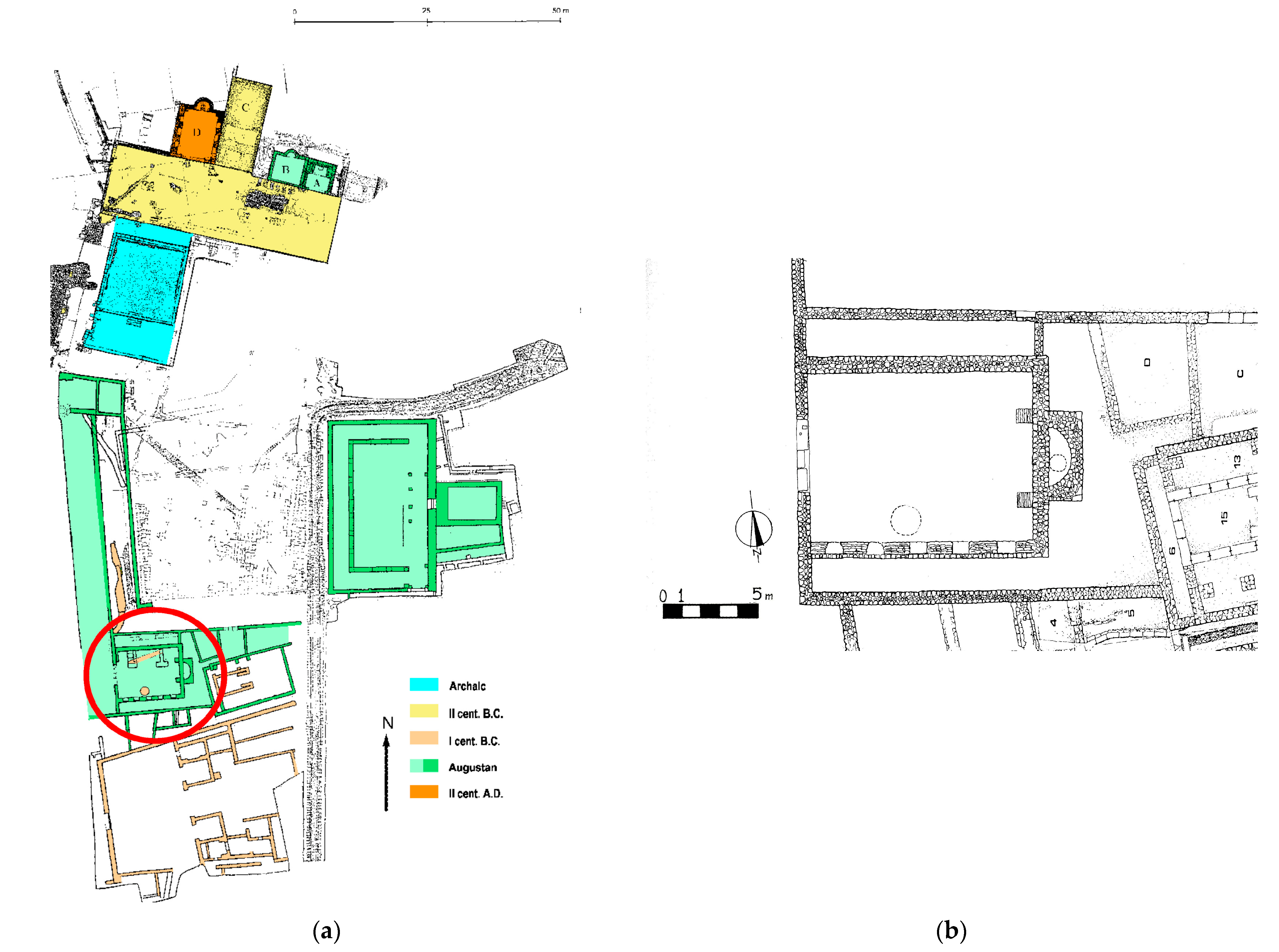
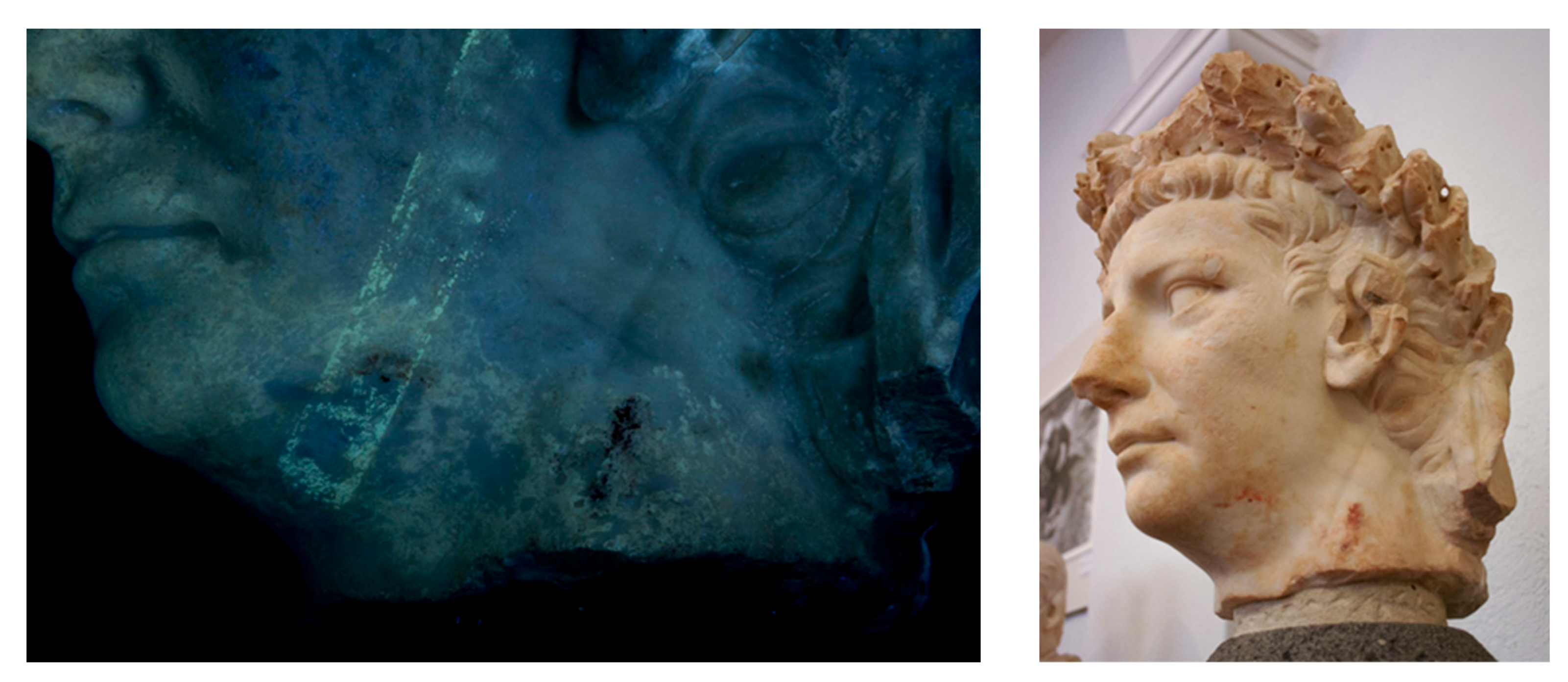
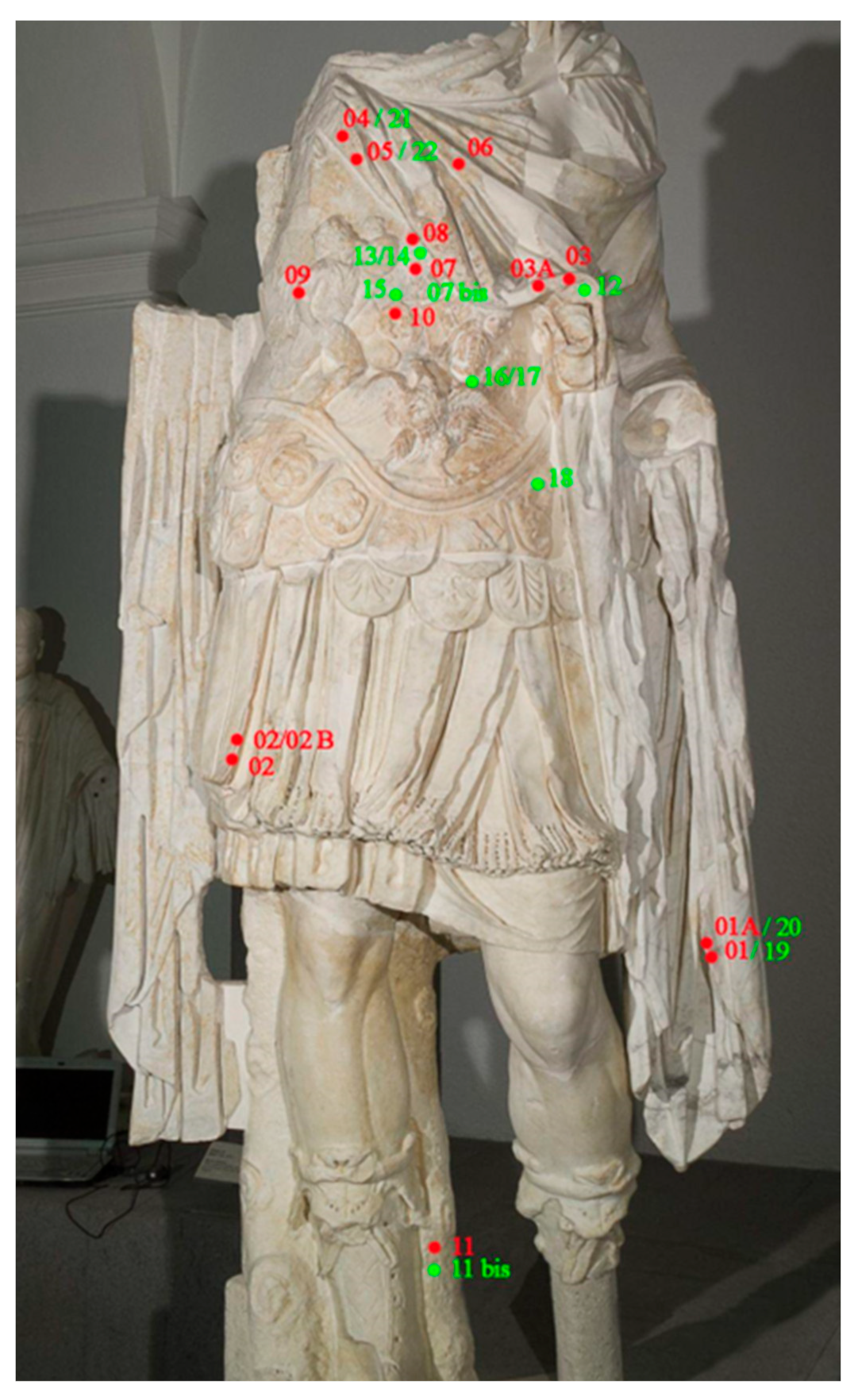
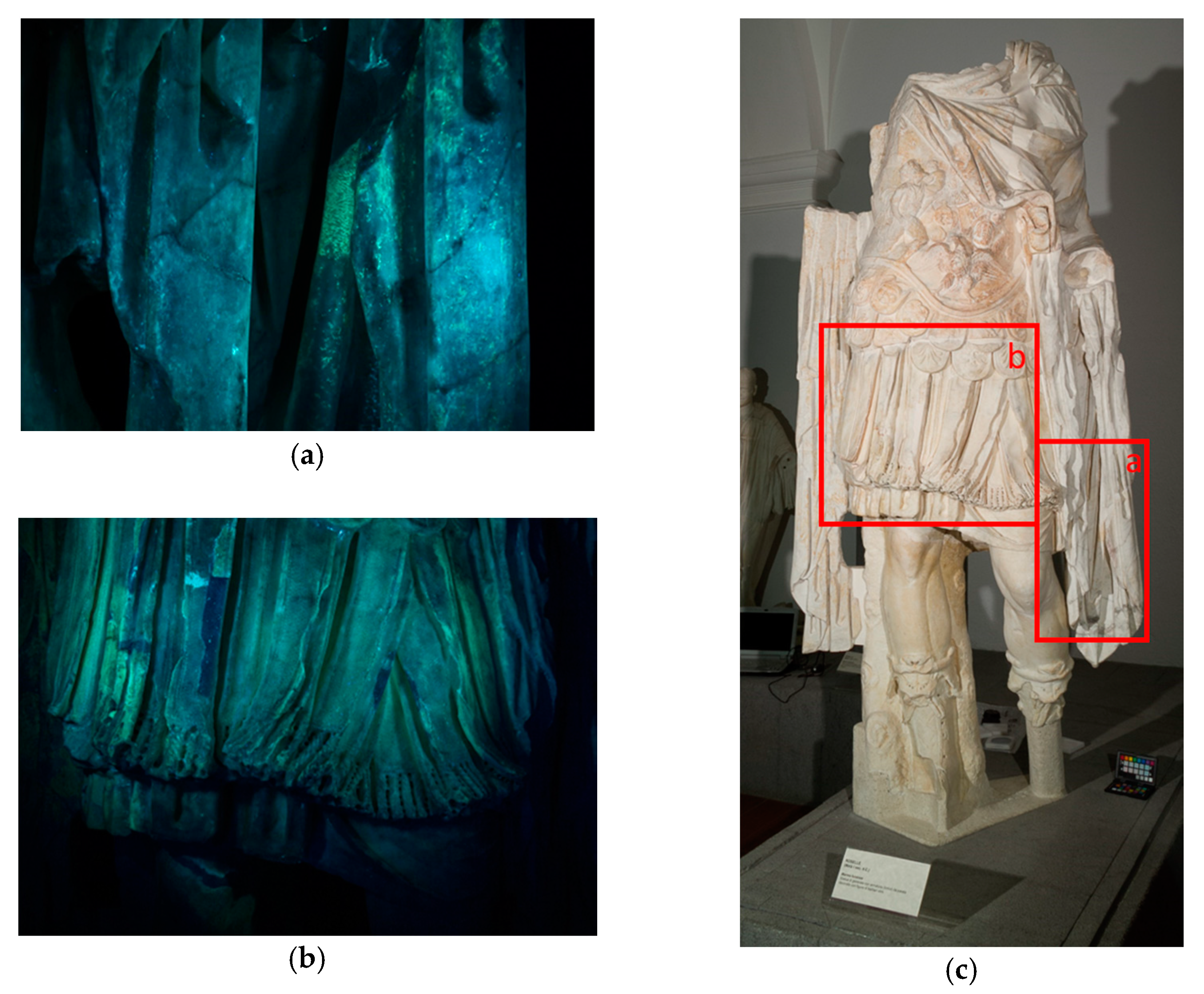
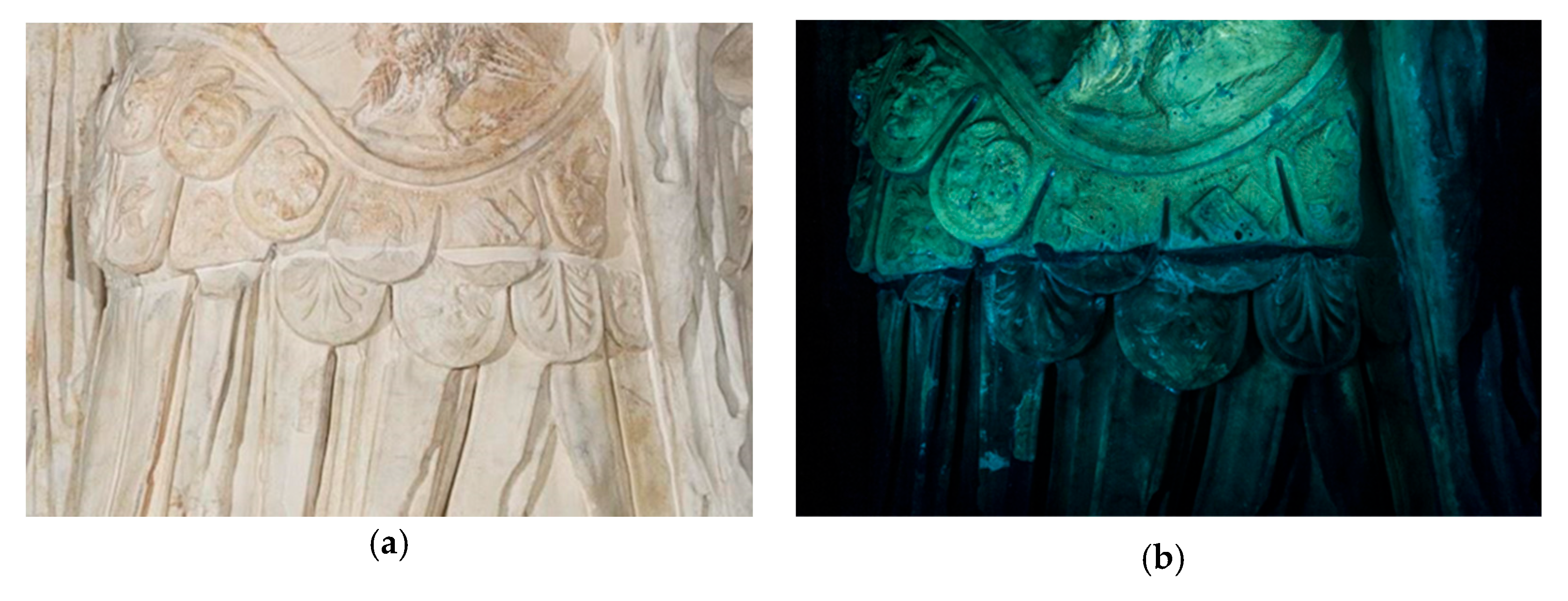

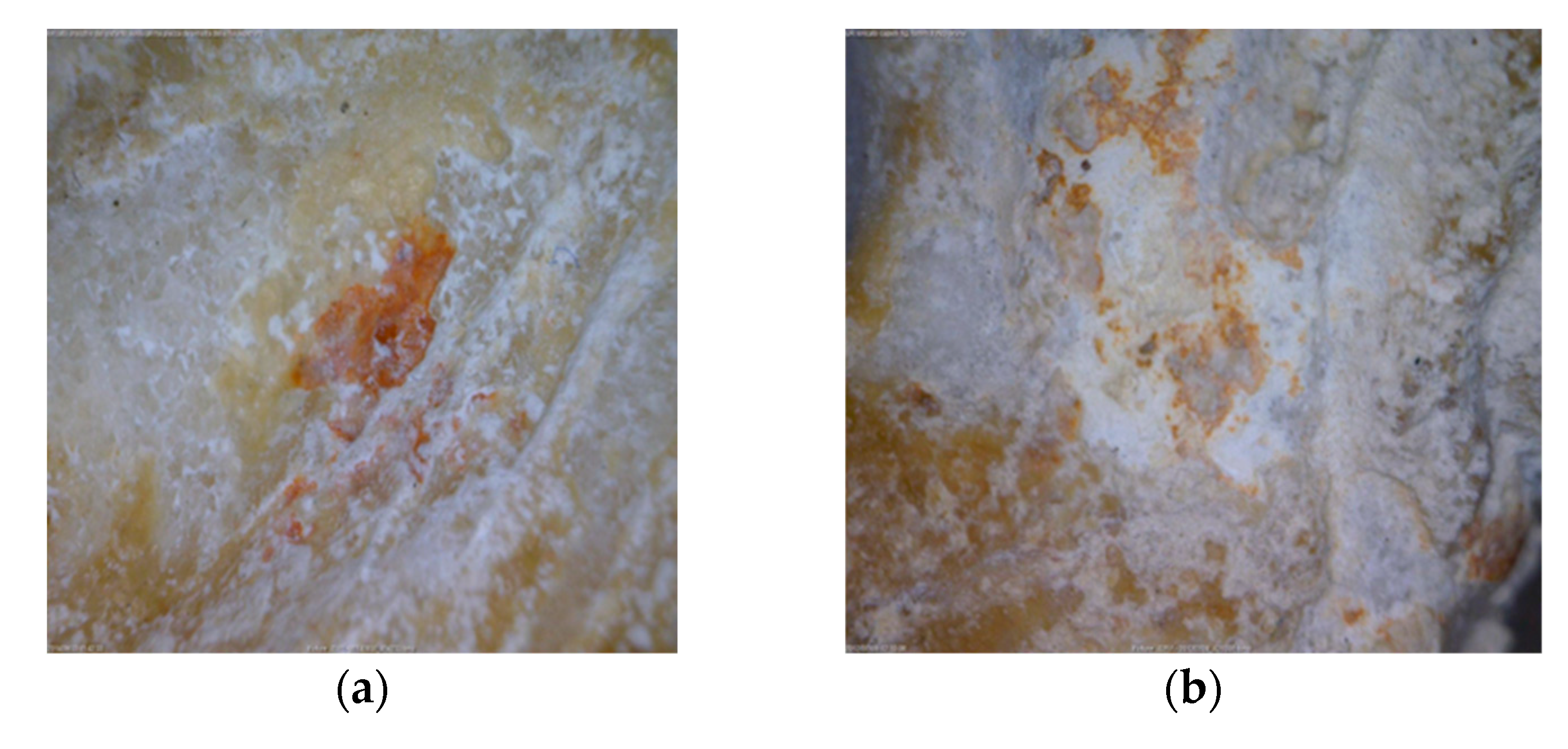
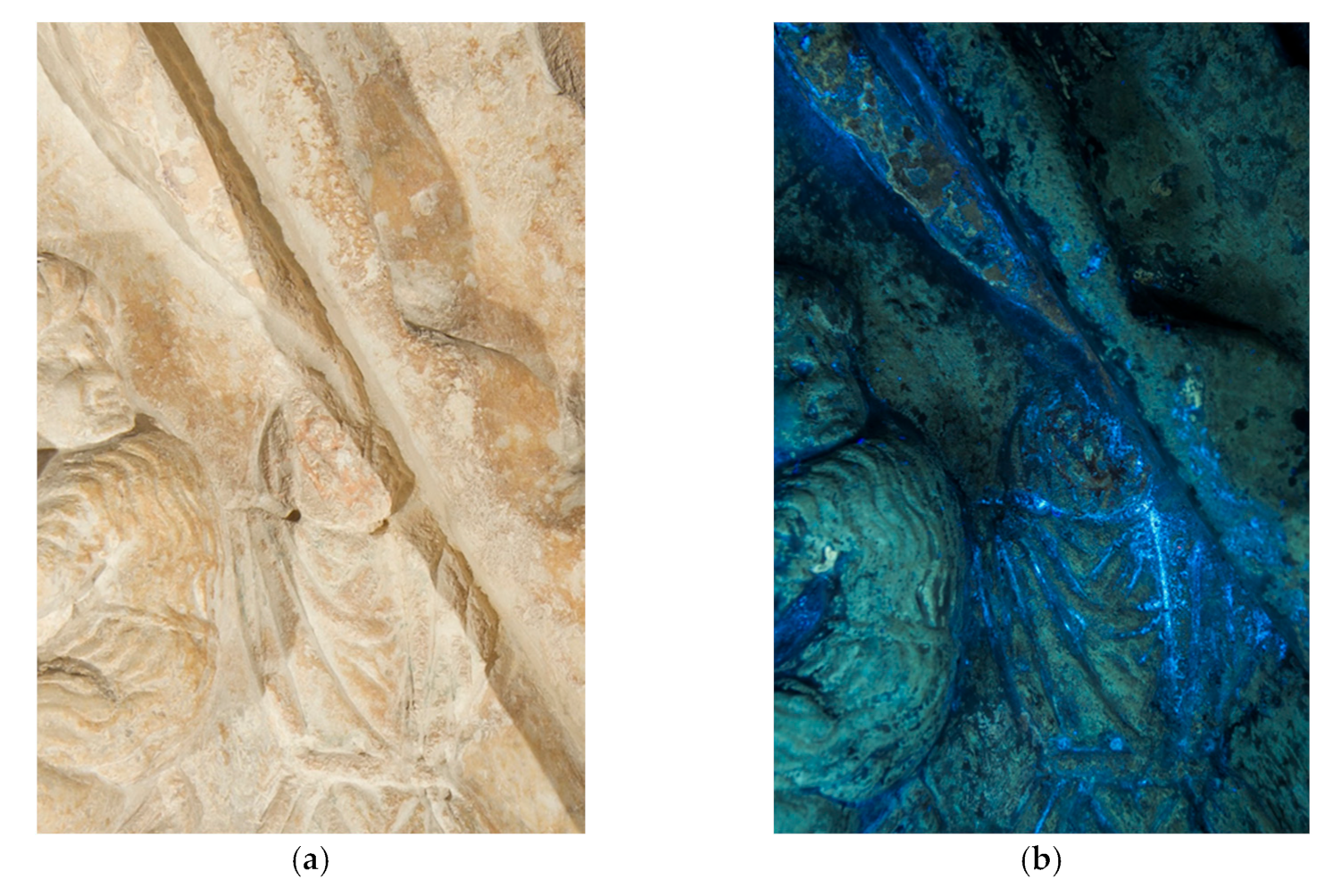
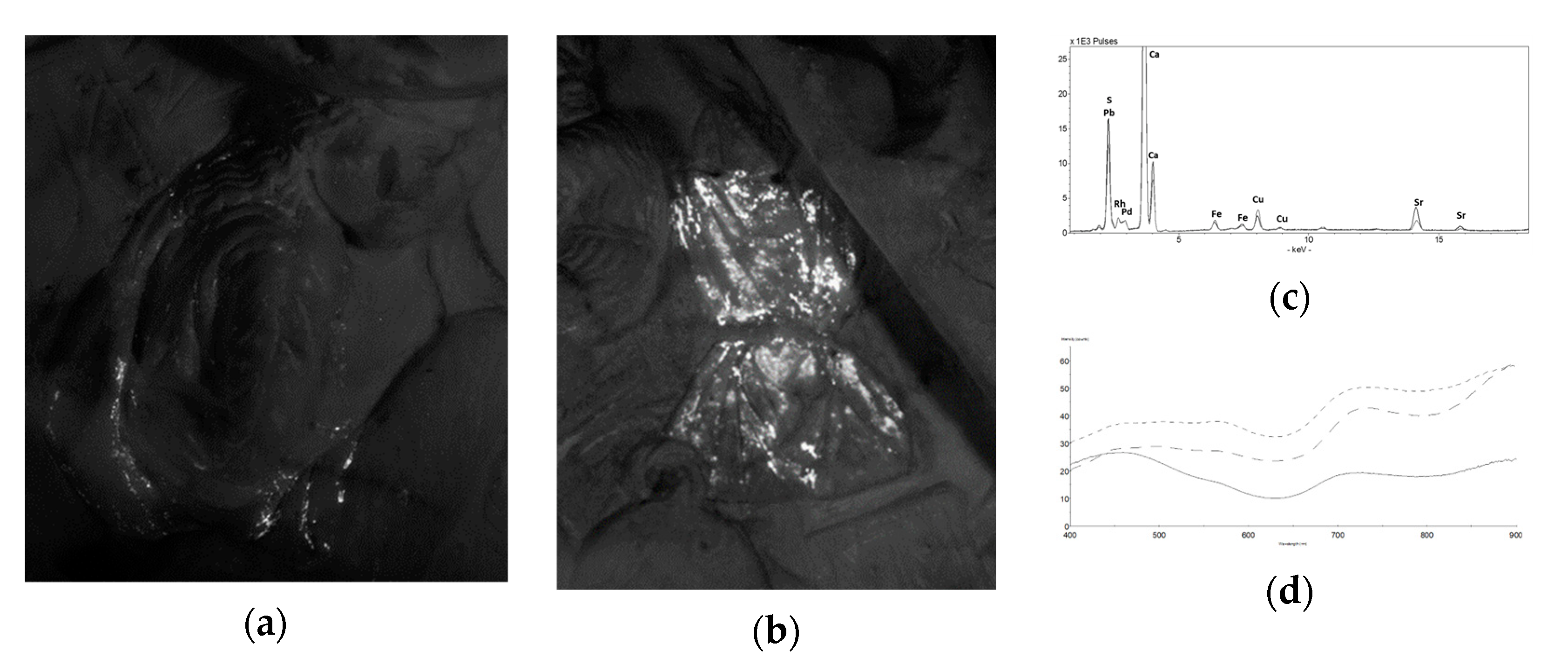

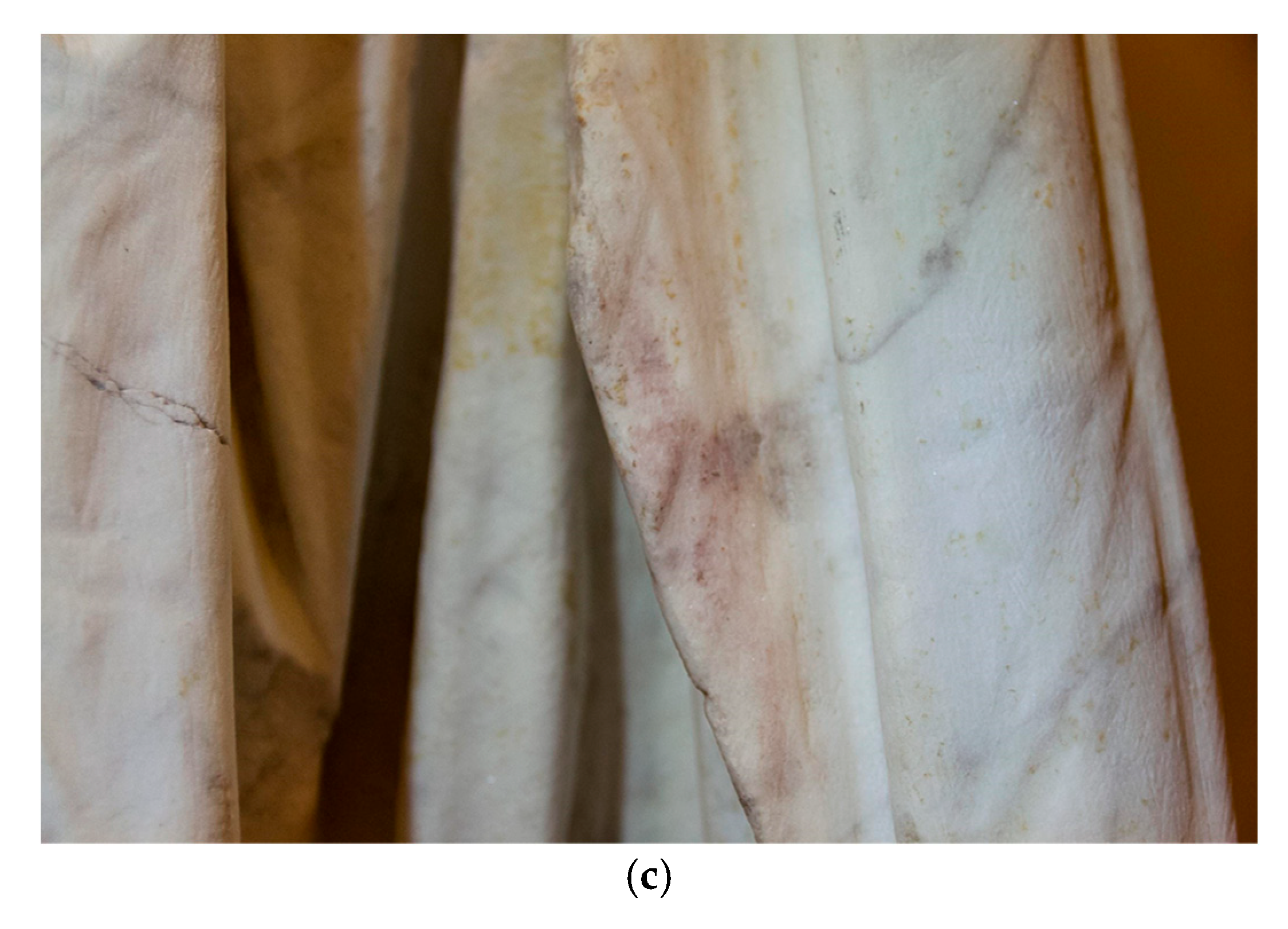

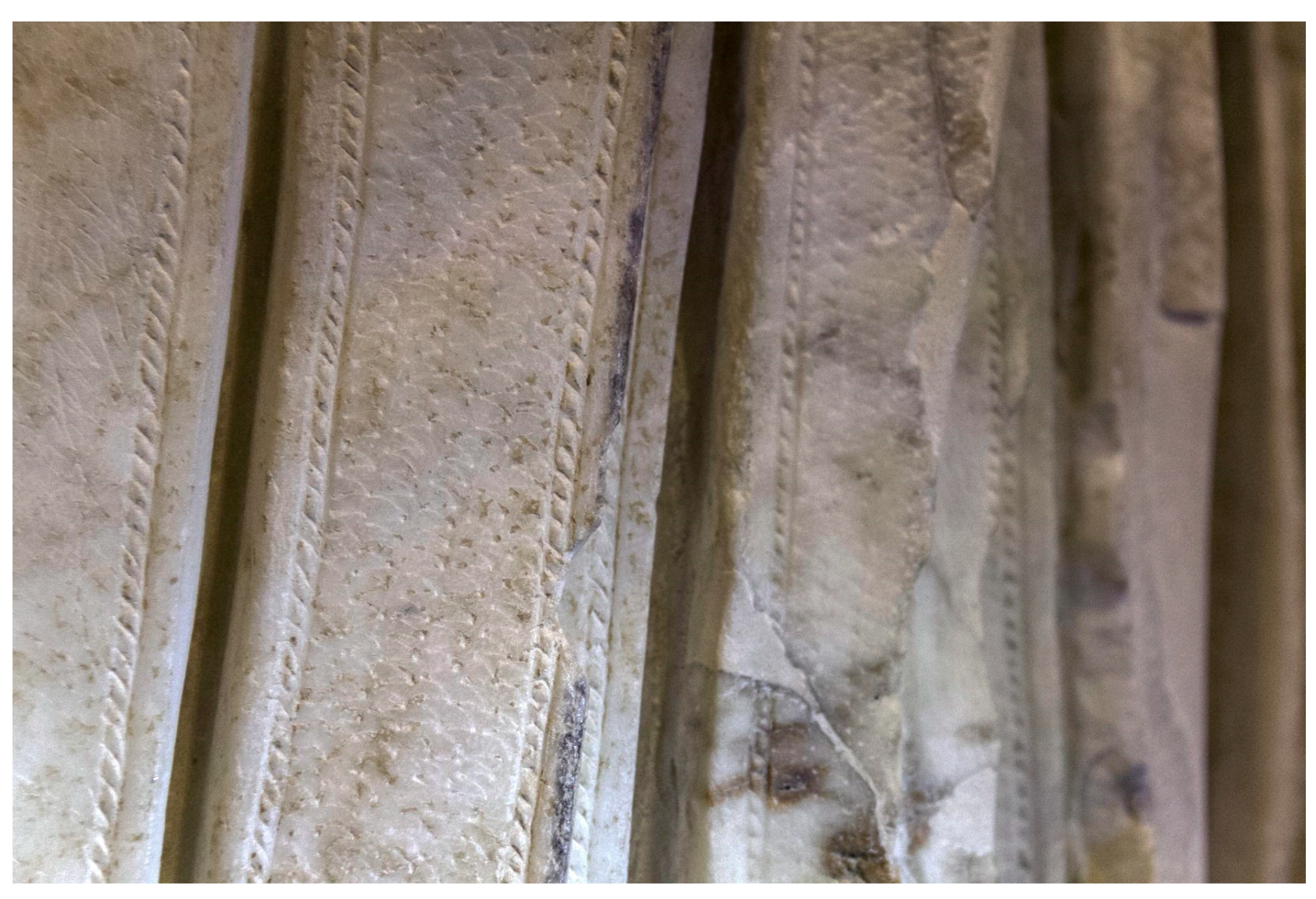
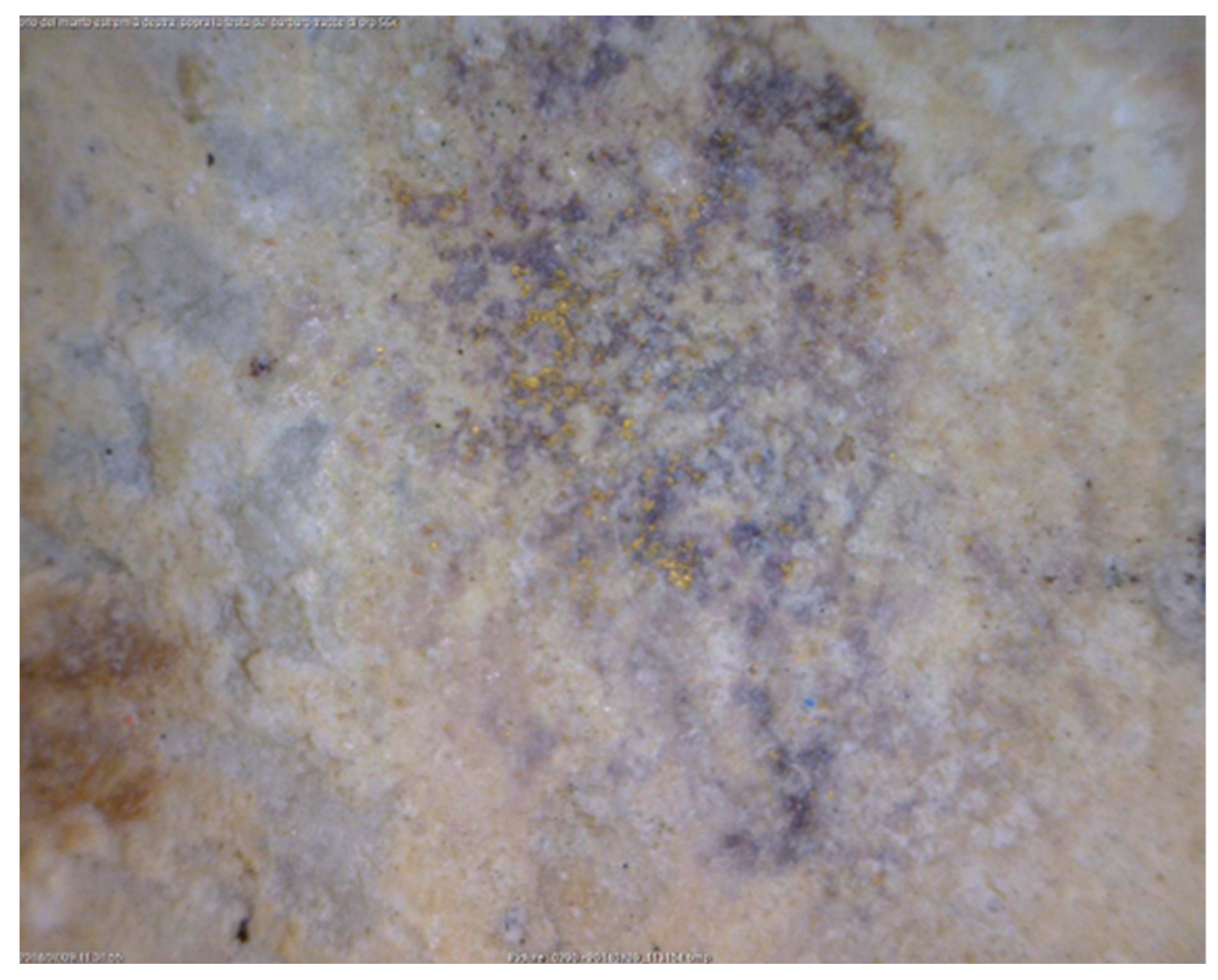

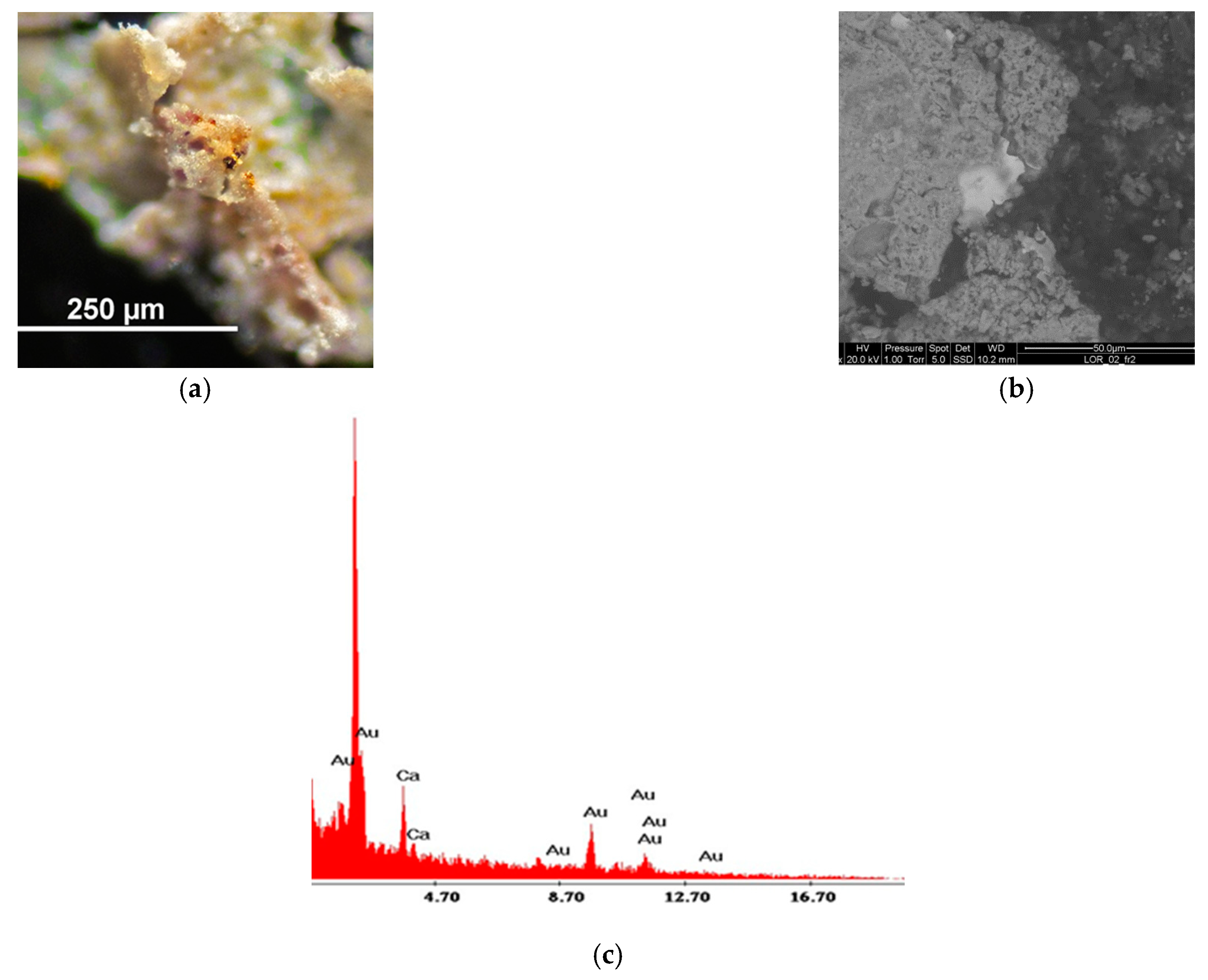
| Technique | Camera | Filters on the Flashes | Filters on Objective |
|---|---|---|---|
| Ultraviolet-induced visible luminescence (UVL) | Canon EOS 7D | B + W 403 UV black | B + W 486 UV/IR cut |
| Visible reflected (VIS) | Canon EOS 7D | B + W 486 UV/IR cut | B + W 486 UV/IR cut |
| Visible-induced luminescence (VIL) | Canon EOS 400D | B + W 486 UV/IR cut | B + W 093 IR |
Disclaimer/Publisher’s Note: The statements, opinions and data contained in all publications are solely those of the individual author(s) and contributor(s) and not of MDPI and/or the editor(s). MDPI and/or the editor(s) disclaim responsibility for any injury to people or property resulting from any ideas, methods, instructions or products referred to in the content. |
© 2023 by the authors. Licensee MDPI, Basel, Switzerland. This article is an open access article distributed under the terms and conditions of the Creative Commons Attribution (CC BY) license (https://creativecommons.org/licenses/by/4.0/).
Share and Cite
Liverani, P.; Bracci, S.; Iannaccone, R.; Lenzi, S.; Magrini, D. New Evidence about the Polychromy of Early Imperial Cycle from the Augusteum of Rusellae (Tuscany). Heritage 2023, 6, 3385-3401. https://doi.org/10.3390/heritage6040179
Liverani P, Bracci S, Iannaccone R, Lenzi S, Magrini D. New Evidence about the Polychromy of Early Imperial Cycle from the Augusteum of Rusellae (Tuscany). Heritage. 2023; 6(4):3385-3401. https://doi.org/10.3390/heritage6040179
Chicago/Turabian StyleLiverani, Paolo, Susanna Bracci, Roberta Iannaccone, Sara Lenzi, and Donata Magrini. 2023. "New Evidence about the Polychromy of Early Imperial Cycle from the Augusteum of Rusellae (Tuscany)" Heritage 6, no. 4: 3385-3401. https://doi.org/10.3390/heritage6040179
APA StyleLiverani, P., Bracci, S., Iannaccone, R., Lenzi, S., & Magrini, D. (2023). New Evidence about the Polychromy of Early Imperial Cycle from the Augusteum of Rusellae (Tuscany). Heritage, 6(4), 3385-3401. https://doi.org/10.3390/heritage6040179







